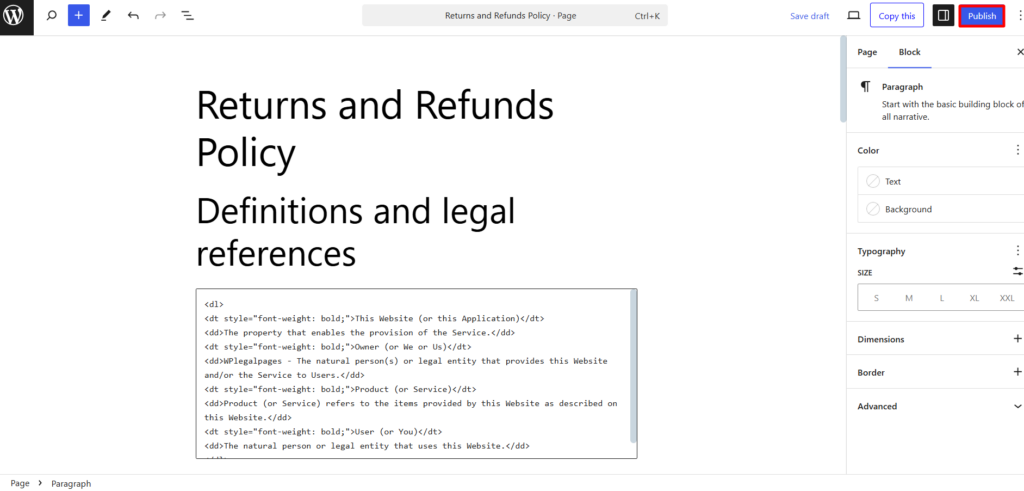Why Your Site Needs to Have a Refund Policy? – 2025

Are you aware of why your website needs an Refund Policy?
Most online business sites fall short of establishing the trust of their visitors. This is because they do not familiarize themselves with their commitments to their stakeholders. If you are one such site owner, it becomes essential for you to put across this information with a bit of extra effort.
We often notice that most service-provider websites may not be aware of this information. They may have a list of traditional terms and conditions that make us avoid them. So, adding information that gives the customers a clear picture of their investments becomes necessary.
The importance of the refund policy cannot be understated, as it directly impacts customer satisfaction and trust in the company’s commitment to a positive shopping experience.
For digital product sellers, a well-defined refund policy is even more critical. Let’s explore why a refund policy must be incorporated and how it can benefit your brand.
- What is a Refund Policy?
- Importance of Refund Policy
- What are the advantages of using a refund policy on your site?
- Key Components of a Refund Policy
- What Are the Legal Requirements for Refund Policies
- Best Practices for Drafting a Refund Policy
- Steps to Implement a Refund Policy for Your Website
- FAQ
- Conclusion
What is a Refund Policy?
A refund policy describes the procedures for returning an item, canceling a service, and getting your money back. It gives customers the information they need, including:
- Items that didn’t meet expectations or were defective are among the items that qualify for a refund.
- How long you have to ask for a refund (e.g., 30 days after purchase).
- The following state should be present in the item: either in its original packaging or unopened.
- Digital downloads, custom orders, and sale items are examples of non-refundable products.
- How will your money be returned (e.g., charged to your card or given as store credit)?
It also describes how to begin the process, such as completing a form or contacting customer support. A good refund policy helps the company and its customers avoid misunderstandings by being fair and transparent.
Importance of Refund Policy
Refund policies aren’t just about returning things; they’re really important for businesses. Here’s why:
- Customers feel safer: When people know they can get their money back if something goes wrong, they’re more likely to buy from you. It gives them peace of mind.
- More straightforward to solve problems: Clear rules make it easier to fix problems if a customer isn’t happy.
- It’s the law: Many places require businesses to have a refund policy, so it’s essential to follow the rules.
- Good for your reputation: A good refund policy makes your business look good. People will likely buy from you again and tell their friends.
- Saves time and money: Having a transparent refund system helps your business run more smoothly and saves you time and effort.
In short, A good refund policy is key to happy customers and a successful business.
What are the advantages of using a refund policy on your site?
Refund policies aren’t just about fixing problems; they help businesses in many ways:
- People feel comfortable buying: When customers know they can return things if they don’t like them, they’re more likely to buy from you in the first place.
- Keeps customers happy: Even if there’s a problem, a good refund policy can turn a bad experience into a chance to keep that customer happy and loyal.
- Reduces chargebacks: When getting a refund is easy, customers are less likely to dispute a charge with their bank, which saves the business money.
- Shows you care: A clear refund policy shows customers that you value their satisfaction and are willing to make things right.
Businesses with fair refund policies often sell more and build stronger customer relationships.
Key Components of a Refund Policy
A comprehensive refund policy must address the following elements:
- Eligibility Criteria: Specify what qualifies for a refund (e.g., defective products, unopened items, or dissatisfaction).
- Return Period: Indicate the timeframe for when customers can request a refund or return.
- Refund Methods: Detail how refunds will be issued (e.g., credit card reversal, store credit, or cash).
- Non-Refundable Items: List products or services exempt from refunds, such as gift cards or personalized goods.
- Return Process: Provide step-by-step instructions on initiating a return, including any required documentation or proof of purchase.
- Processing Time: State how long it will take to review and process refund requests.
By addressing these components, businesses can ensure clarity and fairness, reducing the chances of disputes.
What Are the Legal Requirements for Refund Policies
Adhering to legal standards is a critical aspect of refund policy creation. Key considerations include:
- Regional Regulations: Different countries and states have specific laws governing refunds. For example, the EU mandates a 14-day return period for online purchases under the Consumer Rights Directive.
- Consumer Protection: Refund policies, such as guarantees for defective products or misrepresented services, must not infringe on consumer rights.
- Disclosure Obligations: Businesses may be required to display refund terms on receipts, websites, or store signage.
- Penalties for Non-Compliance: Failing to meet legal requirements can result in fines, lawsuits, or damage to the business’s reputation.
Consulting legal experts ensures your policy meets all necessary guidelines while protecting your business interests.
Best Practices for Drafting a Refund Policy
A well-crafted policy is essential for building customer trust and ensuring smooth transactions. Here are some best practices to consider:
1. Clarity and Transparency
- Use simple language: Avoid jargon and legalese.
- Be specific: Clearly outline the refund conditions, including timeframes, eligible items, and required steps.
- Be upfront about fees: If there are any restocking fees or return shipping costs, disclose them.
2. Accessibility
- Easy to find: Place your refund policy prominently on your website, often in the footer or a dedicated “Returns” page.
- Link clearly: Provide a link to the checkout pages and order confirmation emails.
3. Fairness and Consistency
- Be reasonable: Offer a fair return window (e.g., 30 days) and flexible options.
- Be consistent: Treat all customers equally, regardless of the reason for the return.
- Be open to exceptions: Consider offering exceptions to your policy in certain cases, such as damaged goods or defective products.
4. Customer-Centric Approach
- Focus on customer satisfaction: Frame your policy to show you value your customers’ happiness.
- Provide clear instructions: Guide customers through the return process step-by-step.
- Offer multiple contact options: Make it easy for customers to reach out with questions or concerns.
5. Legal Compliance
- Adhere to local laws: Ensure your policy complies with relevant consumer protection laws in your region.
- Review and update regularly: Keep your policy up-to-date with any regulations or business practices changes.
Example Structure for a Refund Policy
- Introduction: Briefly state your commitment to customer satisfaction.
- Eligibility: Outline the conditions for eligible returns (e.g., unused, undamaged items within a certain timeframe).
- Return Process: Explain the steps in returning an item, including shipping instructions and required documentation.
- Refunds: Specify how refunds will be issued (e.g., original payment method, store credit).
- Exceptions: List any exceptions to your policy (e.g., final sale items, personalized products).
- Contact Information: Provide precise contact details for customer support.
Following these best practices can help protect your business while fostering positive customer relationships.
Steps to Implement a Refund Policy for Your Website
Now that we have understood the importance of the refund policy, let us check how to create on for your website.
Step 1: Installing WP Legal Pages Plugin
Head over to your WordPress dashboard. Hover over Plugins and click on the Add New menu.

Search for Wplegalpages in the search bar above.

Click on the Install Now button.

Next, click on the Activate button.

Next, accept the terms of use of the WPLegalPages plugin.

That’s it. You have successfully installed the WPLegalPages plugin.
Step 2: Create an Account with WP Legal Pages Plugin
Now, to configure settings, follow these steps:
Click on WP Legal Pages, then Create Legal Pages, and generate your legal pages.

This will open the WPLegalPages wizard. From the WPLegalPages wizard, choose the Return and Refund Policy template and click the Create button.

Once you click Create, a popup will appear, asking you to create a new account. Click on New? Create a free account, or if you are an existing user, you can click on Connect your existing account.

Once you Sign up, your account will automatically connect to your site, and you can start creating legal pages for your website.

That’s it. You have created an account, and now you can start creating Your website’s Legal Pages. Now let’s see how we can create a Refund Policy.
You will now see some pro versions of the Templates available in the free version. Click on the Refund Policy option to create a Refund policy for your website.

Fill in the Basic Details and click Next.

Select the appropriate section for your legal policy, then click Next.

Your Refund Policy Preview is ready.
Click the Create and Edit option to add information to your Refund policy.

After you have made the necessary changes, click on Publish.

That’s all! Your Refund Policy is ready with just a few clicks.
FAQ
Yes, but you must clearly state this exclusion in your policy and ensure it complies with local consumer laws.
Outline specific terms for international returns, including shipping costs and customs fees.
Conclusion
In conclusion, a well-crafted refund policy is more than just a set of rules—it’s a crucial tool for building trust, enhancing customer satisfaction, and driving business success. By prioritizing clarity, accessibility, fairness, and legal compliance, you can create a policy that meets your customers’ needs and protects your business interests.
A transparent and customer-focused refund policy signals your commitment to a positive shopping experience, making your brand stand out in a competitive market.
Whether you’re selling physical or digital products, drafting and implementing a robust refund policy will foster loyalty, reduce disputes, and pave the way for long-term growth.
If you liked this article, you can also consider reading:
